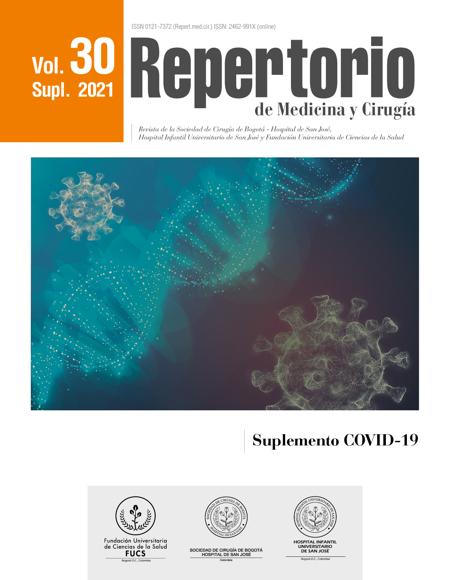SARS-COV-2 cumulative incidence by department in Colombia
Incidencia acumulada por SARS-CoV-2 en los departamentos de Colombia
How to Cite
Download Citation
![]()
![]()

Show authors biography
Introduction: the first case of novel coronavirus pneumonia was notified in Wuhan, China on December 2019. The World Health Organization (WHO) named it “Coronavirus Disease 2019”, COVID-19, on January 2020. It rapidly spread across the globe generating a pandemic declared a public health emergency of international concern. Objective: to show SARS-COV-2 cumulative incidence (CI) in the departments of Colombia as of August 6 2021. Methodology: cross-sectional study based on data released in the Ministry of Health and Social Protection coronavirus webpage. Results: as of August 6 2021, the departments of Colombia showing the highest SARS-COV-2 cumulative incidence were: Bogotá (18.2%), Atlántico (11%), Antioquia (10.6%), San Andrés and Providencia (10.5%) and Quindío (9.8%). Those with the lowest CI are: Vichada (2.5%), Choco (2.9%), Cauca (3.5%), Vaupés (3.7%) and Guajira (4.2%). Conclusion: monitoring the disease through PCR and antigen testing must be continued to enable an analysis of the epidemiological curve for Colombia. The vaccination plan has advanced notably. The author recommends conducting a new national-level incidence analysis after herd immunity is reached in the country.
Article visits 835 | PDF visits 480
Downloads
- Xing J, Sun N, Xu J, Geng S, Li Y. Study of the mental health status of medical personnel dealing with new coronavirus pneumonia. PLoS One. 2020;15(5): e0233145. doi: 10.1371/journal.pone.0233145. DOI: https://doi.org/10.1371/journal.pone.0233145
- Wang C, Horby PW, Hayden FG, Gao GF. A novel coronavirus outbreak of global health concern. Lancet. 2020;395(10223):470-473. doi: 10.1016/S0140-6736(20)30185-9. DOI: https://doi.org/10.1016/S0140-6736(20)30185-9
- Zhang Y, Zhang H, Ma X, Di Q. Mental Health Problems during the COVID-19 Pandemics and the Mitigation Effects of Exercise: A Longitudinal Study of College Students in China. Int J Environ Res Public Health. 2020;17(10):3722. doi: 10.3390/ijerph17103722. DOI: https://doi.org/10.3390/ijerph17103722
- Díaz Pinzón JE. Valoración de la Incidencia del COVID-19 en Colombia para el año 2020. Repert Med Cir. 2021;30(Núm. Supl.1): 1–9. https://doi.org/10.31260/RepertMedCir.01217372.1174 DOI: https://doi.org/10.31260/RepertMedCir.01217372.1174
- Pita Fernández S, Pértegas Díaz S, Valdés Cañedo F. Medidas de frecuencia de enfermedad [Internet]. Fisterra; 2004 [Citado 9 de agosto de 2021]. Disponible en: https://www.fisterra.com/formacion/metodologia-investigacion/medidas-frecuencia-enfermedad/
- Pinto A. Prevalecia e Incidencia [Internet]. 2014 [Citado 21 de julio de 2020]. Disponible en: https://es.slideshare.net/alexpinto18/prevalencia-e-incidencia-2?next_slideshow=2
- Quintana L. Medidas de frecuencia en epidemiología [Internet]. 2015 [Citado 21 de julio de 2020]. Disponible en: https://es.slideshare.net/lualberts20/medidas-de-frecuencia-en-epidemiologa-2015
- Ministerio de Salud y Protección Social [Internet]. 2021 [Citado 9 de agosto de 2021]. Disponible en: https://coronaviruscolombia.gov.co/Covid19/index.html
- Díaz Pinzón JE. Estimación de la prevalencia del COVID-19 en Colombia. Repert Med Cir. 2020;29(Núm. Supl.1):99–102. https://doi.org/10.31260/RepertMedCir.01217372.1115 DOI: https://doi.org/10.31260/RepertMedCir.01217372.1115
- Díaz Pinzón, J. E. (2020). Análisis de los resultados del contagio del COVID-19 respecto a su distribución geográfica en Colombia. Revista Repertorio De Medicina Y Cirugía, 60–64. https://doi.org/10.31260/RepertMedCir.01217372.1082
- Díaz Pinzón JE. Análisis de los resultados del contagio del COVID-19 respecto a su distribución geográfica en Colombia. Repert Med Cir. 2020;29(Núm. Supl.1):60–64. https://doi.org/10.31260/RepertMedCir.01217372.1082 DOI: https://doi.org/10.31260/RepertMedCir.01217372.1082












